Notes: Garston station was situated on the Cheshire Lines Committee (CLC) main line between Liverpool Central and Manchester Central. The Cheshire Lines Committee was a joint railway that was made up from the Great Northern Railway (GNR), the Manchester, Sheffield & Lincolnshire Railway (MS&LR) and the Midland Railway (MR) with each company holding one-third of the shares. The section of line on which Garston Station stood opened from a point just to the west of the station at Cressington Junction to Skelton Junction on 1 August 1873, the section of line from Glazebrook to Manchester opening a month later on 2 September 1873. The CLC had previously had to use the LNWR route through Warrington Arpley to reach their terminal facilities at Brunswick, in Liverpool, from Manchester. Trains using this route had stopped at the nearby Garston Dock station.
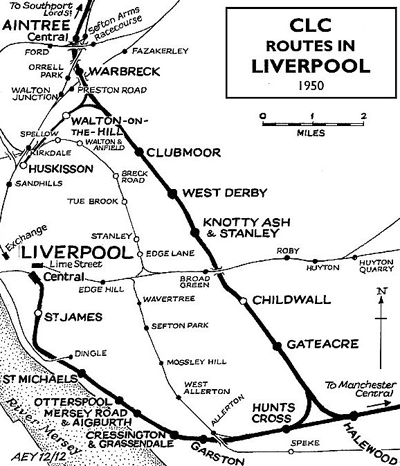 With their own direct route the CLC were able to open their own Garston station on 1 April 1874. It was in a cutting west of Woolton Road. Its main entrance consisted of a brick building at street level on the south side of the line. The building was single-storey at street level but two-storey at platform level and it contained booking facilities and storage areas. Steps descended to the down (Liverpool direction) platform which had two single-storey brick buildings which provided waiting facilities and a two-storey stationmaster’s house. A section of canopy supported on iron pillars was provided on the platform. At the west end of the down platform there was a goods bay with loading ramp. With their own direct route the CLC were able to open their own Garston station on 1 April 1874. It was in a cutting west of Woolton Road. Its main entrance consisted of a brick building at street level on the south side of the line. The building was single-storey at street level but two-storey at platform level and it contained booking facilities and storage areas. Steps descended to the down (Liverpool direction) platform which had two single-storey brick buildings which provided waiting facilities and a two-storey stationmaster’s house. A section of canopy supported on iron pillars was provided on the platform. At the west end of the down platform there was a goods bay with loading ramp.
Leading from the street level booking hall was a footbridge which gave access to the up (Manchester direction) island platform with two faces. This platform was provided with an extensive canopy, again supported on iron pillars, beneath which were timber-built waiting rooms. At the east end of the platform there were toilet facilities for gentlemen in the form of a cast iron urinal. The footbridge continued beyond the island platform to Hartington Road providing direct access to the station from the north side of the line.
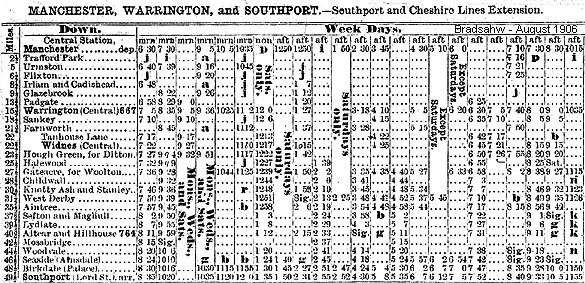 |
A signal box was located west of the station on the north side of the line. It was a type St/CL timber box with a 20 lever frame. It controlled the main line through the station, an up loop that served the north face of the up platform and the west end down platform goods bay.
At the time of opening Garston station was served by local trains operating to various points along the main line between Liverpool Central and Manchester. The CLC had its own coaches but it never had any locomotives as it had been agreed that the MS&LR would provide them.
From 1 December 1879 Garston was served by trains between Liverpool Central and Walton-on-the-Hill following the opening of the CLC North Liverpool Extension Line. From 1 September 1884 the station also had services to Southport Lord Street when the Southport & Cheshire Lines Extension Railway (SC&LER) opened from Aintree to Southport Lord Street.
Garston developed into a bustling outer suburb of Liverpool, and its station was well served to cater for commuter traffic. It was also very close to a market which generated further passenger traffic. The December 1895 timetable showed Garston as having 31 up and 38 down trains Monday-to-Friday as seen in the table below.There was an extra up train on Saturdays but only 36 down services. There were 10 trains in each direction on Sundays.
In 1897 the MS&LR changed its name to the Great Central Railway. By this time the CLC had established a fast express service between Liverpool Central and Manchester Central noted for its excellent punctuality and well able to compete with its rivals; these express services, however, passed through Garston non-stop.
At the grouping of 1923 the CLC remained independent but its owning companies became the London & North Eastern Railway (LNER) which had two-thirds of the shares and the London Midland & Scottish Railway (LMS) which had one-third. After 1923 it was the LNER which provided the locomotives for the CLC services.
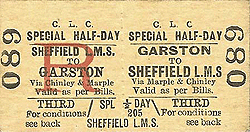 In the summer of 1932 Garston Station had 14 weekday services running westbound that originated from the main line; most started from Manchester Central, and all ran through to Liverpool Central. The first departure was at 6.52am and the last at 11.45pm. There were 13 eastbound services, most of which ran to Manchester Central. The first departure was at 5.17am and the last was at 10.45pm. Garston was also served by trains between Gateacre and Liverpool Central, and there were a couple of services to Southport Lord Street. In the summer of 1932 Garston Station had 14 weekday services running westbound that originated from the main line; most started from Manchester Central, and all ran through to Liverpool Central. The first departure was at 6.52am and the last at 11.45pm. There were 13 eastbound services, most of which ran to Manchester Central. The first departure was at 5.17am and the last was at 10.45pm. Garston was also served by trains between Gateacre and Liverpool Central, and there were a couple of services to Southport Lord Street.
On the 1 January 1948 Garston became part of the nationalised British Railways (London Midland Region). Services between Liverpool Central and Southport Lord Street ended from 7 July 1952 when the former SC&LER closed to passenger services. However for the remainder of the 1950s Garston remained a busy suburban station with regular services to Liverpool Central, Gateacre, Warrington Central, Stockport Tiviot Dale and Manchester Central. There were also a couple of peak hour services to Aintree Central. Many main line express services also continued to pass through the station. In 1960 Diesel Multiple Units (DMUs) were introduced onto the local services, but the Aintree service ceased on the 7 November 1960. The summer 1962 timetable showed 44 up and 41 down trains Monday-to-Friday. There were 16 up and 16 down trains on Sundays.
The Reshaping of British Railways (‘Beeching’) report of 1963 recommended the closure of Liverpool Central station and the diversion of all of its main line services to Liverpool Lime Street. In the April 1966 timetable Garston had 20 trains to Warrington Central, 18 to Gateacre and 43 services to Liverpool Central. The first eastbound departure left at 6.34 am for Warrington Central. The first westbound departure left for Liverpool Central at 6.33 am. The last train going east was for Warrington Central at 10.04 pm and the last train for Liverpool Central was at 11.37pm.
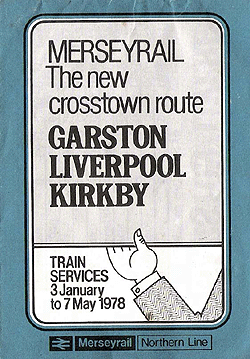 In September 1966 all Liverpool Central train services, except those serving Gateacre, were diverted to Liverpool Lime Street, leaving the CLC route about one mile east of Garston station. This left Garston with only the service between Liverpool Central and Gateacre. British Rail wanted to withdraw the Gateacre service so that it could close Liverpool Central. Opposition from passengers and the local authorities ensured that the service continued. In September 1966 all Liverpool Central train services, except those serving Gateacre, were diverted to Liverpool Lime Street, leaving the CLC route about one mile east of Garston station. This left Garston with only the service between Liverpool Central and Gateacre. British Rail wanted to withdraw the Gateacre service so that it could close Liverpool Central. Opposition from passengers and the local authorities ensured that the service continued.
Garston station signal box closed on 23 July 1967 after the up loop had been removed. It was demolished straight away.
In 1969 the Merseyside Passenger Transport Executive (MPTE) was formed. Building upon reports produced by the local authorities the MPTE obtained an Act in 1971 which would create what became the ‘Merseyrail’ network. The line through Garston was to be electrified and linked to an underground network in Central Liverpool. To enable the construction of the underground lines Liverpool Central station had to close and, as a result, the Gateacre service would be withdrawn. This service was discontinued on 17 April 1972, and Garston station was closed. Prior to closure the station had been allowed to deteriorate, and after closure it became completely derelict. At some point in the later half of 1977 the street level building was demolished along with the footbridge and the extensive station canopies. All structures were removed from up platform, except the urinal.
Garston station reopened on 3 January 1978 as a terminus station for the Merseyrail network’s Northern Line extension. This had seen the former CLC line as far as Garston electrified with third rail. Only the former Liverpool direction platform was in use. The former up direction platform remained out of use as did the line between Garston and Hunts Cross West Junction. A former platform waiting room was converted into booking and waiting facilities. A through access road was created on the south side of the station which passed directly in front of the new main entrance. The road was created as part of a proposed bus/rail interchange. The bus drivers trade union refused to allow its members to use the new road and it was years before agreement could be reached.
In its newly constituted state Garston once again became very busy, having a regular train service to Kirkby via Liverpool Central and a new underground line which ran at a 20-minute frequency for most of the day.
In 1983 the electrification was extended a couple of miles further east to Hunts Cross where connections with the main line were possible. The up platform was brought back into use but with only one platform face. A covered footbridge was provided at the western end of the station. The iron urinal was removed and donated to the National Railway Museum. On 16 May 1983 Garston became a through station again when the extension opened to Hunts Cross. With the opening of the extension trains ran between Hunts Cross and Southport via central Liverpool at a 15-minute frequency for most of the day (reducing to 30 minutes after 19.00) on Monday-to-Saturday.
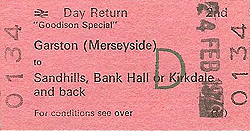 In the late 1990s Merseytravel, the local authority transport authority, explored the option of creating a South Liverpool Parkway Station. This new facility would serve the former CLC line and the former LNWR main line to London. It was decided to locate the new station just to the east of Garston Station. Its west end platform ramps would be less than 10 metres away from Garston’s east end ramps. In the late 1990s Merseytravel, the local authority transport authority, explored the option of creating a South Liverpool Parkway Station. This new facility would serve the former CLC line and the former LNWR main line to London. It was decided to locate the new station just to the east of Garston Station. Its west end platform ramps would be less than 10 metres away from Garston’s east end ramps.
In the early part of the twenty-first century work was authorised to create South Liverpool Parkway which replaced both Garston and nearby Allerton stations. On 11 June 2006 the new station opened. Allerton had already closed in 2005, but Garston closed for the second and final time on the 10 June 2006, and it was demolished shortly afterwards. Nothing remained of it in 2013.
Click here to see tables showing Garston train services.
Tickets from Michael Stewart, Bradshaw from Chris Hind, Merseyrail timetables from Paul Wright and route map by Alan Young
Sources:
- The Cheshire Lines Committee, by P Bolger, Heyday Publishing Company 1984.
- Bradshaw Timetable December 1895.
- Bradshaw Timetable July 1922.
- LMS Timetable Summer 1932.
- BR (LMR) Summer Timetable 1948.
- BR (LMR) Summer Timetable 1962.
- Cheshire Lines Committee Signal Box Register, M J Addison & J D Dixon 1996.
- Roads, Rails & Ferries of Liverpool, J Joyce, Ian Allan 1983.
For other stations on the Liverpool to Manchester
CLC line click on the station name: Liverpool
Central, Liverpool
St. James, Brunswick, Otterspool, Halewood, & Manchester
Central.
See also: Gateacre |

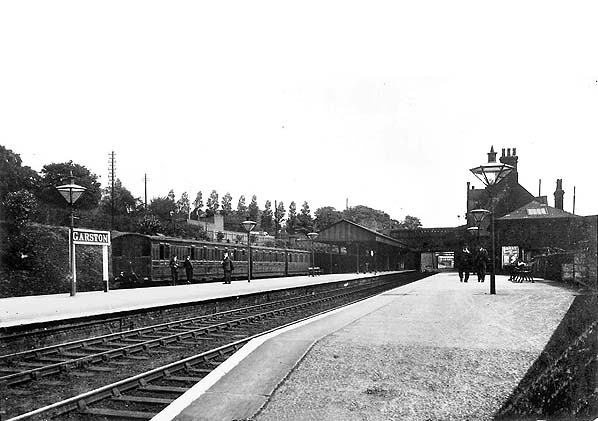
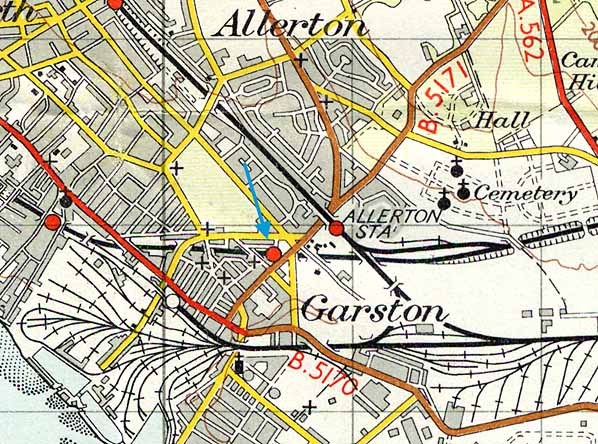
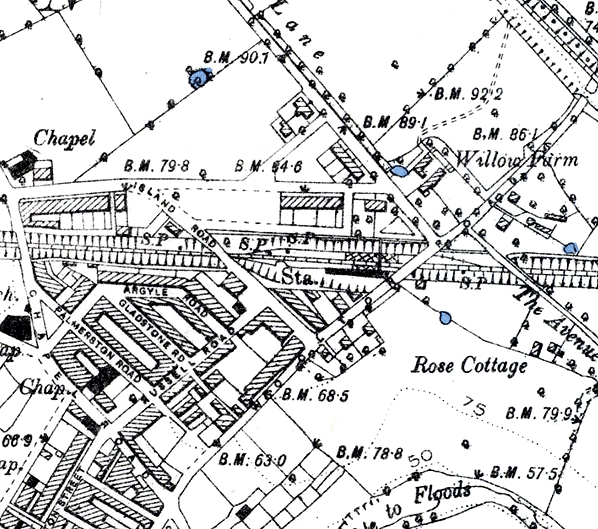
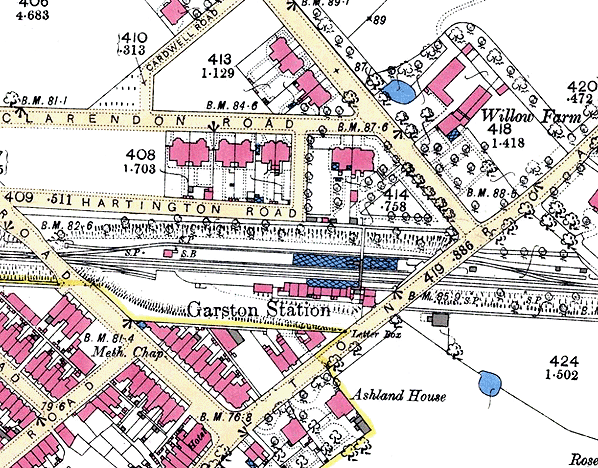
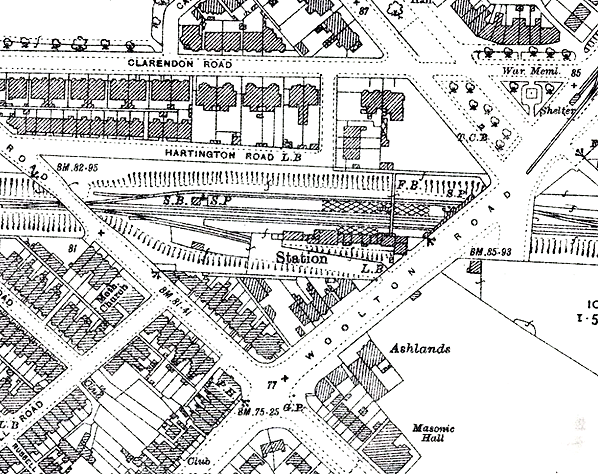
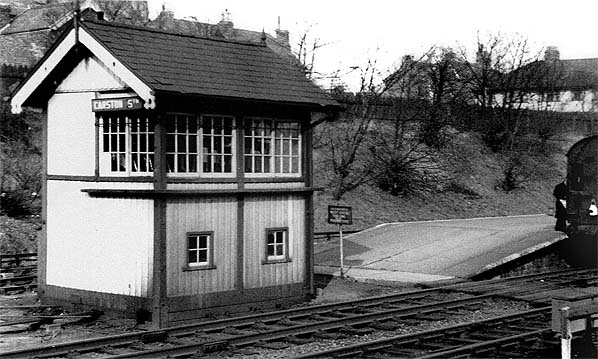
1.jpg)
2.jpg)
4.jpg)
5.jpg)
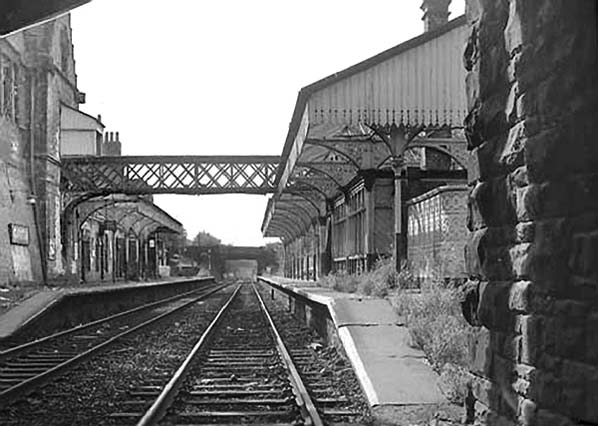
site_28.feb2012aey.jpg)
 With their own direct route the CLC were able to open their own Garston station on 1 April 1874. It was in a cutting west of Woolton Road. Its main entrance consisted of a brick building at street level on the south side of the line. The building was single-storey at street level but two-storey at platform level and it contained booking facilities and storage areas. Steps descended to the down (Liverpool direction) platform which had two single-storey brick buildings which provided waiting facilities and a two-storey stationmaster’s house. A section of canopy supported on iron pillars was provided on the platform. At the west end of the down platform there was a goods bay with loading ramp.
With their own direct route the CLC were able to open their own Garston station on 1 April 1874. It was in a cutting west of Woolton Road. Its main entrance consisted of a brick building at street level on the south side of the line. The building was single-storey at street level but two-storey at platform level and it contained booking facilities and storage areas. Steps descended to the down (Liverpool direction) platform which had two single-storey brick buildings which provided waiting facilities and a two-storey stationmaster’s house. A section of canopy supported on iron pillars was provided on the platform. At the west end of the down platform there was a goods bay with loading ramp. 
 In the summer of 1932 Garston Station had 14 weekday services running westbound that originated from the main line; most started from Manchester Central, and all ran through to Liverpool Central. The first departure was at 6.52am and the last at 11.45pm. There were 13 eastbound services, most of which ran to Manchester Central. The first departure was at 5.17am and the last was at 10.45pm. Garston was also served by trains between Gateacre and Liverpool Central, and there were a couple of services to Southport Lord Street.
In the summer of 1932 Garston Station had 14 weekday services running westbound that originated from the main line; most started from Manchester Central, and all ran through to Liverpool Central. The first departure was at 6.52am and the last at 11.45pm. There were 13 eastbound services, most of which ran to Manchester Central. The first departure was at 5.17am and the last was at 10.45pm. Garston was also served by trains between Gateacre and Liverpool Central, and there were a couple of services to Southport Lord Street.
 In September 1966 all Liverpool Central train services, except those serving Gateacre, were diverted to Liverpool Lime Street, leaving the CLC route about one mile east of Garston station. This left Garston with only the service between Liverpool Central and Gateacre. British Rail wanted to withdraw the Gateacre service so that it could close Liverpool Central. Opposition from passengers and the local authorities ensured that the service continued.
In September 1966 all Liverpool Central train services, except those serving Gateacre, were diverted to Liverpool Lime Street, leaving the CLC route about one mile east of Garston station. This left Garston with only the service between Liverpool Central and Gateacre. British Rail wanted to withdraw the Gateacre service so that it could close Liverpool Central. Opposition from passengers and the local authorities ensured that the service continued.  In the late 1990s Merseytravel, the local authority transport authority, explored the option of creating a South Liverpool Parkway Station. This new facility would serve the former CLC line and the former LNWR main line to London. It was decided to locate the new station just to the east of Garston Station. Its west end platform ramps would be less than 10 metres away from Garston’s east end ramps.
In the late 1990s Merseytravel, the local authority transport authority, explored the option of creating a South Liverpool Parkway Station. This new facility would serve the former CLC line and the former LNWR main line to London. It was decided to locate the new station just to the east of Garston Station. Its west end platform ramps would be less than 10 metres away from Garston’s east end ramps.

 Home Page
Home Page